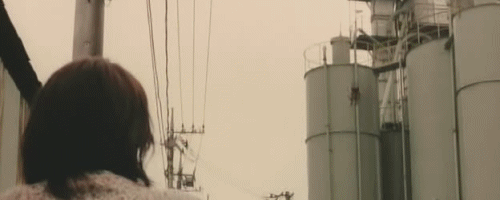Pulse: Dangers of Connectivity
Kurosawa Kiyoshi's 2001 horror movie, Pulse, examines a generation of Japanese youth confounded and isolated by the new explosive wave of technological advancement and interconnectivity. Centering on a group of three coworkers at a plant shop after the mysterious suicide of a fourth, the film showcases a youth that is both social and solitary as every because of these new technological developments; they are all depressed and alone. Kudo Michi, the protagonist, even relates this specifically when referring to the dots that cannot interact in her program, saying that they would destroy each other.
A vast portion of this movie takes place with characters in complete isolation, whether traveling somewhere, spending time in their apartments, or on their computers. Even the moments where multiple people share a screen are accentuated by close-ups and tight angles on the individuals, furthering the sense of alone-ness. Formally. much of this movie also takes place entirely in the dark or in sterile, artificially lit rooms; even during broad daylight, blinds are often shuttered and we can hardly see details of the frame. There is a strong emphasis on the shades of grey, brown, black, and white, with occasional touches of bright red. This sense of tonal flatness even further harshens our sense of Isolation of ourselves and the characters.
It is fascinating that the narrative and stylistic change to the artificial and technological mirror the practical, real-life change that occurred during this time in Japanese Cinema. According to Mitsuyo Wada-Marciano, this stylistic change in J-horror specifically is directly impacted by the genre's mode of production itself. Produced for low budgets on predominantly digital equipment, these movies were at the same time independent of and inherently reliant upon the studios' modes of finance and distribution. Essentially, the filmmakers themselves, such as Kurosawa Kiyoshi, were trapped in a similar predicament by their ties to technology as the characters in Pulse.
A vast portion of this movie takes place with characters in complete isolation, whether traveling somewhere, spending time in their apartments, or on their computers. Even the moments where multiple people share a screen are accentuated by close-ups and tight angles on the individuals, furthering the sense of alone-ness. Formally. much of this movie also takes place entirely in the dark or in sterile, artificially lit rooms; even during broad daylight, blinds are often shuttered and we can hardly see details of the frame. There is a strong emphasis on the shades of grey, brown, black, and white, with occasional touches of bright red. This sense of tonal flatness even further harshens our sense of Isolation of ourselves and the characters.
It is fascinating that the narrative and stylistic change to the artificial and technological mirror the practical, real-life change that occurred during this time in Japanese Cinema. According to Mitsuyo Wada-Marciano, this stylistic change in J-horror specifically is directly impacted by the genre's mode of production itself. Produced for low budgets on predominantly digital equipment, these movies were at the same time independent of and inherently reliant upon the studios' modes of finance and distribution. Essentially, the filmmakers themselves, such as Kurosawa Kiyoshi, were trapped in a similar predicament by their ties to technology as the characters in Pulse.

Comments
Post a Comment